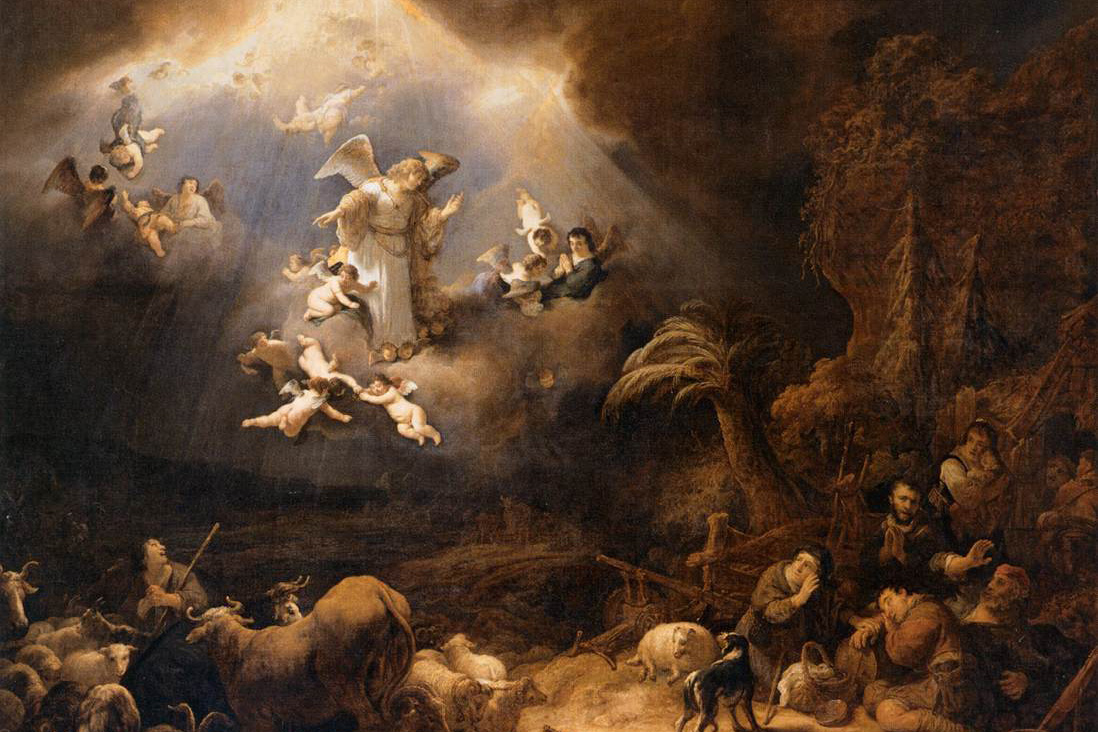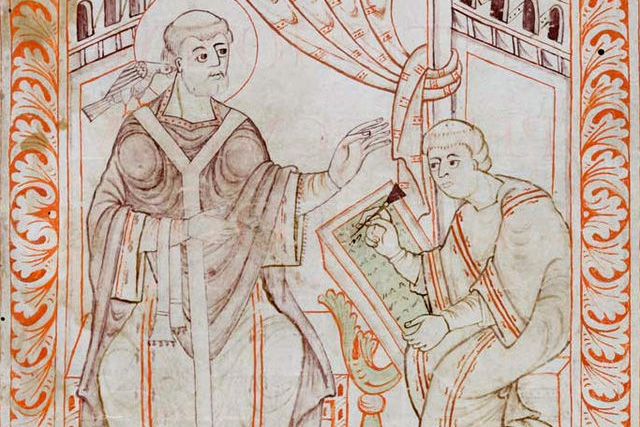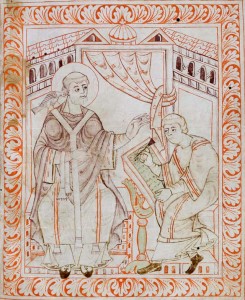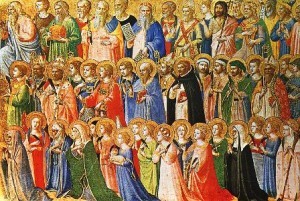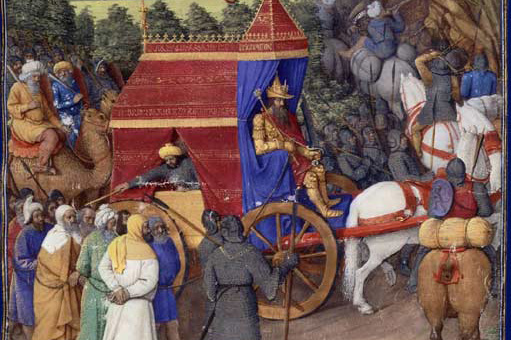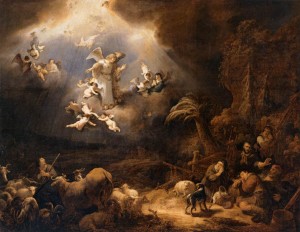 The mysteries of Christmas are many. Among them is the mystery of the music heard that night. The angels shouted the great declaration, “Glory to God in the Highest,” and creation takes it up as a song. But why this music? Is it merely window dressing, or does it disclose a mystery to us? Is it merely for us, or do the angels also have need of the declaration?
The mysteries of Christmas are many. Among them is the mystery of the music heard that night. The angels shouted the great declaration, “Glory to God in the Highest,” and creation takes it up as a song. But why this music? Is it merely window dressing, or does it disclose a mystery to us? Is it merely for us, or do the angels also have need of the declaration?
As always with the things of God, there are realities far deeper than most of us imagine. But tonight’s Christmas feast weaves together, among many other mysteries, those of music and descent, and points up to music and ascent.
You see, over my head I hear music in the air. There must be a God somewhere. And the Lord descends to one song so that we might ascend to a new song in a new place: in the highest heavens. Let’s see how.
I. Divine Condescension – The text says, Now there were shepherds in that region living in the fields and keeping the night watch over their flock. The angel of the Lord appeared to them and the glory of the Lord shone around them, and they were struck with great fear. The angel said to them, “Do not be afraid; for behold, I proclaim to you good news of great joy that will be for all the people. For today in the city of David a savior has been born for you who is Christ and Lord. And this will be a sign for you: you will find an infant wrapped in swaddling clothes and lying in a manger” (Lk 2:8-12).
We look first to the divine descent of Jesus. Note that Jesus, who is called Savior, the Anointed One, and Lord, is said to be found wrapped in swaddling clothes and lying in a feed box, a trough from which animals are fed.
What sort of King and Lord is this? It is almost a divine comedy. Imagine the shepherds quaking in fear at the presence of an awesome angel. And then the angel tells them that they will find the Christ lying in a feed box, in a stable somewhere nearby. One can almost image one shepherd saying to another in a sort of whisper, “Did that angel say ‘feeding trough’?” And then the other nervous shepherd whispers back, “Yeah, that’s what he said.” It is comedic because it is so anti-climactic.
Indeed, there is a remarkable divine condescension here! The Lord did not merely descend from Heaven to earth. He descended to one of the lowest places on the earth, to a stinking cave, among animals, and has for His bed a feeding trough meant for animals.
And though Bethlehem was called the “City of David” it was hardly fit for a King. It was then, and is now, a run-down, dusty, ramshackle, poor town.
So here is the King of the Universe born, not in a stately palace, but in a stinking pen; not in a cozy cradle, but in a messy manger.
Yet God speaks eloquently in this poverty and condescension. Here is the Bread of Life, in a town called Bethlehem (House of Bread), lying in a feed trough. In His littleness and poverty He is approachable and calls to the poor.
But do not miss the radical nature of this descent! So radical was it, that this very thing is said in tradition to be the reason that one-third of the angels rebelled, turning against God and falling to the earth as demons (fallen angels). In both Jewish apocryphal writings as well as the writings of the Fathers of the Church, Lucifer, one of the highest ranking angels and among the seraphim, recoiled at the idea that God would choose to join Himself to His physical creation. Man was a mere mud doll to Lucifer, something and someone so far beneath him as to merit no real attention. The thought of God becoming flesh caused Lucifer to rebel, and he took a third of the angels with him in rebellion against so absurd a plan: God as mud doll, taking on human flesh and being joined to mere material creation. It was unbecoming, beneath the dignity of the spiritual world!
Condescension was unthinkable to Lucifer’s pride and he fell, refusing to accept such an absurd notion. Ever since that time, he and the fallen angels with him have envied the human person whom God was pleased to indwell, and by this envy have sought to destroy our truest dignity: an indwelling relationship with God.
Why this condescension? He condescends today to one song in order that we may ascend one day with Him to a new place and sing a new song. To what song does He descend and to what song will we ascend? Let’s read on.
II. Dancing Choirs – The text says, And suddenly there was a multitude of the heavenly host with the angel, praising God and saying, “Glory to God in the highest and on earth peace to those on whom his favor rests.”
But the angels who did not fall had rejoiced in God’s plan and longed for its day! Thus on this day, as the Lord is manifest to the world, the highest angels who descended with Christ at the Annunciation now send word through and to the lower ranks of angels and a great heavenly throng makes the declaration, Glory to God in the Highest, and on Earth Peace! The great hymn that is sung (or more literally, declared) is not just for the human family; according to the Fathers of the Church it is also a signal to the lower ranking angels from the higher ranking angels. All Heaven has revealed to it the mystery hidden for ages and generations but now made manifest to his holy ones (Col 1:26). A mystery, a wisdom which is hidden, which God ordained before the world, unto our glory (1 Cor 2:7). …The things which have now been announced to you by those who preached the good news to you through the Holy Spirit sent from heaven, things into which angels long to look (1 Peter 1:12).
Perhaps a little background will help understand the dance of the choirs and the communication that takes place.
The inner life of the Trinity, according to sacred tradition and the teaching of the Fathers, is not a mere static vision of the three persons for one another. The inner of the live of the Trinity is a movement of love. The Father loves the Son; the Son loves the Father; the Holy Spirit processes between them in this great movement which the Greek Fathers call the divine perichoresis, a kind of dance of love.
And the angels are arranged around God in ranks or choirs somewhat like concentric circles. And they, too, take up the dance of love, passing love and revelation from God through each rank or choir and back again. Yes, here is the great dance, the perichoresis of God’s inner love radiating out to angels, down through the ranks to us, and from us back through them to God.
The nine choirs (ranks) of angels are divided into three tiers, or triads, each with specific concerns:
- The Highest Tier: Seraphim, Cherubim, and Thrones, who concern themselves with contemplating the glory of God. It is the six-winged seraphim who sing the Sanctus, “Holy, Holy, Holy Lord, God of Hosts” (Isaiah 6:3).
- The Middle Tier: Dominations, Virtues, and Powers, who are known as the “angels of creation” because they concern themselves with the ordering of the cosmos and the causes of things.
- The Lower Tier: Principalities, Archangels, and Angels, who concern themselves with the minute ordering of the universe and with specific causes, including the welfare of people. Each human being, each church, and each country has a guardian angel.
Thus, the “Gloria in Excelsis” is a declaration of praise not just overheard and taken up by humanity; it is not just a hymn of praise, it is a dance and a passing of information down the chain of angelic choirs. The highest choirs of angels have descended with the Word made Flesh, Jesus, since it is their role to surround Him with perpetual adoration.
The Church Father, Origen, has the higher angels say,
“If he has put on mortal flesh, How can we remain, doing nothing!? Come Angels, let us descend from heaven!” That is why [Scripture says] there was a multitude of the heavenly Hosts praising and glorifying God when Christ was born. Everything is filled with angels! (Hom in Ex. 1:7)
And now at Jesus’ birth, the Seraphim, Cherubim, and Thrones signal the lower angels: “This is He, who is Lord of all Creation; He who is ever to be adored and glorified.” The lower angels take up the information and cry out, “Glory to God in the Highest.”
Another Church Father, Pseudo-Dionysius, says of this great heavenly hymn that is declared,
The highest order composed of Seraphim, Cherubim, and Thrones, and which is closest of all, by reason of its dignity, to the secret sanctuary of God [instructs] the second order, composed of Dominations, Virtues and Powers. This order in turn reveals the mysteries to the lower tier of angels the Principalities, Archangels and Angels who are set in charge of the human hierarchies (Hier Ceol. 9,2).
And thus the great “Gloria in Excelsis Deo” resounds in the heavens, not just on the earth. The angels are given the good news along with us! An ancient hymn from the Liturgy of St. James says of this moment,
- Rank on rank the host of heaven
- spreads its vanguard on the way,
- as the Light of light descendeth
- from the realms of endless day,
- that the powers of hell may vanish
- as the shadows clear away.
- At his feet the six-winged seraph,
- cherubim, with sleepless eye,
- veil their faces to the presence,
- as with ceaseless voice they cry,
- “Alleluia, alleluia,
- Alleluia, Lord most high!”
And to us on earth comes the call to hear the music, the great hymn of praise and instruction, and to respond with our souls!
I have it on the best of authority that as the shepherds heard the great song of the angels, one of them said, Over my head I hear music in the air. There must be a God somewhere!
All of creation echoed that night with the song of the angels communicating this truth to one another and to us.
Angels we have heard on high
Sweetly singing o’er the plains,
And the mountains in reply
Echo back the joyous strains
Gloria!
The animals, too, lifted their eyes heavenward, and one was said to say,
Said the little lamb to the shepherd boy,
do you hear what I hear
Ringing through the sky, shepherd boy,
do you hear what I hear
A song, a song, high above the trees
With a voice as big as the sea
With a voice as big as the sea!
But why all this music at the divine descent? Because the music (Gloria in Excelsis) and the descent are related and meant to signal and lead us higher. Christ descends to one song in order to lead us to an even nobler and higher song,
III Destiny of the Christian – The Psalm says, Sing to the LORD a new song, sing to the LORD, all you lands. Sing to the LORD; bless his name (Ps 96:1-2).
So again, this music (Gloria in Excelsis) and the descent are related and meant to signal and lead us higher. Christ descends to one song in order to lead us to an even nobler and higher song, a song sung in the highest heavens! And without this descent and this first song, the second song and our ascent are impossible. Christ descends to the song of the lower heavens so that we, by His saving grace, may ascend to the place and song of the higher heavens.
And what is this new song and place? Isaiah heard the music and saw the place:
I saw the Lord sitting upon a throne, high and lifted up; and his train filled the temple. 2 Above him stood the seraphim; each had six wings: with two he covered his face, and with two he covered his feet, and with two he flew. 3 And one called to another and said: “Holy, holy, holy is the Lord of hosts; the whole earth is full of his glory.” 4 And the foundations of the thresholds shook at the voice of him who called, and the house was filled with smoke. 5 And I said: “Woe is me! For I am lost; for I am a man of unclean lips, and I dwell in the midst of a people of unclean lips; for my eyes have seen the King, the Lord of hosts!” 6 Then flew one of the seraphim to me, having in his hand a burning coal which he had taken with tongs from the altar. 7 And he touched my mouth, and said: “Behold, this has touched your lips; your guilt is taken away, and your sin forgiven” (Isaiah 6:1-8).
Here is a our new song, a higher song, one sung only in the highest Heaven before the throne of God, one sung only by the redeemed: Holy, Holy, Holy Lord God of Hosts! At every Mass, our High Priest, Jesus, speaking through His ministerial priest says, Lift up your hearts! We reply that we have them lifted up to the Lord. In other words we are told to come up higher, to come into the Holy of Holies in Heaven, to come before the throne and sing the hymn of the highest in Heaven.
Our ascent to this highest place is made possible only by the Lord’s descent to the lowest places here: the manger, the Cross, and Sheol. In the early Church, only the baptized could sing the Sanctus at Mass. The unbaptized were not allowed to attend. The catechumens, though permitted to sing the hymn of the lower heavens (The Gloria), were dismissed prior to the singing of the Sanctus, the song of the higher heavens. Only when we are caught up higher by grace can we hear and join the Sanctus. And one day it will be fully our song when God, who descended, says to us, “Come up higher.” And then, by Him who descended, we will ascend and sing a new song to the Lord!
Over my head I hear music in the air. There must be a God somewhere. And the Lord descends to one song so that we might ascend to a new song in a new place, in the highest heavens. May HE, who descends to the manger today, cause you to ascend to the highest heavens to sing that new song.

